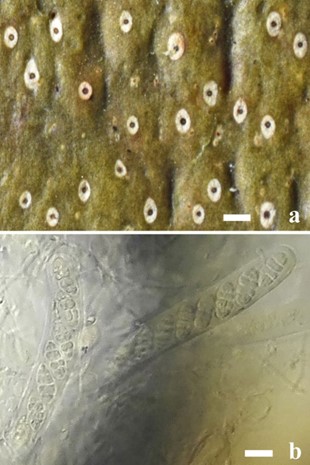Viridothelium Lücking, M.P. Nelsen & Aptroot in Lücking et al., Lichenologist 48: 758 (2016).
MycoBank number: MB 816877; Index Fungorum number: IF 816877; Facesoffungi number: FoF 08826; 11 morphologically defined species (Aptroot and Lücking 2016; Cáceres and Aptroot 2017); molecular data available for three species (Lücking et al. 2016).
= Exiliseptum R.C. Harris, Acta Amazonica 14(1–2, Suppl.): 65 (1986) [1984].
Type species: Exiliseptum ocellatum (Müll. Arg.) R.C. Harris, Acta Amazonica 14(1–2, Suppl.): 66 (1986) [1984].
Lichenized on bark in terrestrial, chiefly lowland to lower montane tropical to temperate forest habitats. Thallus distinctly corticate, yellow-brown to olive-green. Photobiont Trentepohlia. Ascomata solitary to aggregated or diffusely pseudostromatic, immersed to erumpent, brown-black but usually covered by thallus layer except for ostiolar area, coriaceous to carbonaceous, ostiolate, ostiole apical to lateral, sometimes fused. Excipulum prosoplectenchymatous, brownish. Hamathecium comprising 0.5–0.7 µm wide para- physoids, hyaline, straight, branched and anastomosing, embedded in a thick, gelatinous matrix. Asci 4–8-spored, bitunicate, fissitunicate, clavate to oblong, short pedicellate,
with a non-amyloid ocular chamber. Ascospores irregularly arranged to biseriate, oblong-fusiform, hyaline, septate to rarely muriform, with slightly thickened distosepta and more or less rectangular lumina, smooth-walled, not constricted at the septa, often with a gelatinous sheath. Pycnidia rare, immersed to erumpent, visible as black dots. Conidia aseptate, bacillar, hyaline.
Chemistry: orange anthraquinone known from one species
Type species: Viridothelium virens (Tuck. ex Michener) Lücking, M.P. Nelsen & Aptroot in Lücking et al., Lichenologist 48: 759 (2016).
Notes: For key and discussion see Aptroot and Lücking (2016). The genus currently includes 11 species (Cáceres and Aptroot 2017). The genus Exiliseptum, described by Harris (1986), was later considered a member of Polymeridium with a corticate thallus (Aptroot and Cáceres 2014), and this view was followed in the recent synopsis on Trypetheliaceae (Aptroot and Lücking 2016). However, upon re-examination of the type material (Fig. 81), we believe that this taxon may be congeneric with Viridothelium, in which case it would provide an earlier name for that genus. We have refrained from formal implementation of this finding, as the phylogenetic placement of odd lineages in Trypetheliaceae is somewhat unpredictable and we anticipate collecting authentic material for sequencing.

Fig. 81 Exiliseptum ocellatum (holotype). a, b habitus and asci with ascospores. Scale bars: a = 1 mm, b = 10 µm
Species
